By: Margaret Sharp
Sports are always on the move.
Rugby for example, once gamboling across public commons in 19th century England, was punted into the American melting pot and emerged as American football. Traces of rugby’s contributions can be found in the lexicon with words like “touchdown” and “line of scrimmage.”” In rugby you physically touch the ball down to score. While the scrum, a packed down version of the line, evolved into scrimmage.
Sports aren’t static; they are continuing to evolve. This year marks the 45th anniversary year of Title IX. In the US, women’s participation in sports has increased from 15% in 1972, to 45% today. The North American market is worth close to $70 billion dollars, and sports are worth about $620 billion globally. This series will look at sports, how they evolved, and what their future holds.
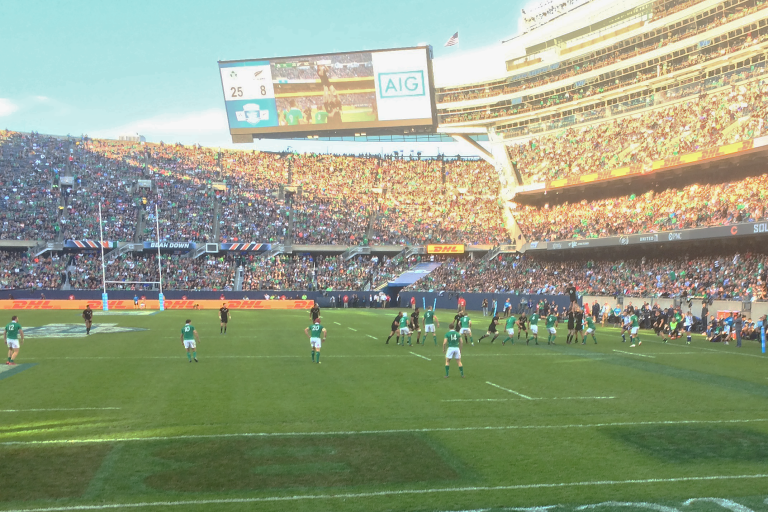
Ireland v. New Zeland All-Blacks Rugby in Chicago’s Soldier Field, 2016. Photo by author.
What does the world play now?
If I asked you to name a couple sports you would probably say baseball, basketball, or football (the American kind), but a global view of would result in a very different list. Taking a look at factors such as participation, fan base, viewership, and the like, seem like niche sports. Due to the fuzziness of data collection on such a large scale and the necessity of estimation of casual and unreported games, the lists vary somewhat. However, what is clear (even to the NFL-boosters among us) is that soccer is the world’s most popular sport.
Ok. Fine, but how did we get here?
Most cultures around the world have some form of athletic competition. These competitions mostly evolved from some form of martial training or hunting/survival skills: archery, wrestling, javelin throw, judo, sprinting, marathon, shooting, weightlifting. Athletics and combat sports were used to evaluate individual soldiers or hunters for combat readiness or survival. Team sports, those involving two teams, a ball, and a goal, evolved from exercises to get troupes working together as a unit. Each culture around the globe has their own unique forms of wrestling, martial arts, athletics, and team sports. Over the centuries (particularly since the mid-19th century), the rules were written down, and the sports formalized. Today, the main commercial sports are governed by large organizations and carefully maintained.
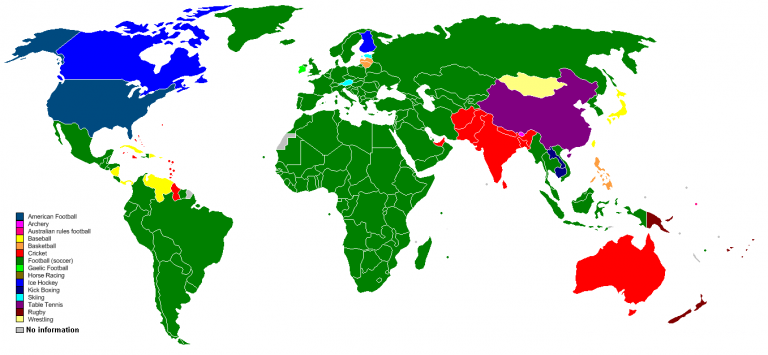
Most popular in each country. Photo credit: Lalolince on Wikimedia.
The evolution of different sports
The evolution of sports from military training to casual recreation to high-class leisure to mass entertainment is a fascinating rabbit hole to lose yourself in. First, it is hard to understate the impact that British colonialism has had on modern sport. Here is the short version – compare side by side a map of the British Empire, and the world’s most popular sports; it is clear. If you were colonized by the British, you are probably playing their sports – soccer, cricket, rugby, or one of their offspring – baseball, American football, ice hockey, Aussie rules.
But what sports were you playing before the British invasion? In Northeastern America it was (and to some extent still is) lacrosse. In Africa you were likely wrestling. In Southern India you were likely playing khabaddi. The Chinese court played cuju, and in New Zealand it was tī rākau as well as water sports like surfing and canoing. Yet, these traditional sports bear some striking similarities to the sports of today. The British contribution may have as much to do with organization as importation (or cultural hegemony). Note: the world of is as diverse as the people who inhabit it, and this is a completely inadequate list of the traditional sports of these regions. I focused on the most prominent sport, one which is still played today.
| Sports cradles | |||
|---|---|---|---|
| Name | Region | Description | First played. |
| Kabaddi | India, Tamil Nadu state | A little like capture the flag, or tag, but without a ball or flag and you need to hold your breath. Tackling allowed. | Unknown, probably ancient |
| Cuju | China | A military sport similar to soccer, played with a stone ball to build up the soldiers strength | 11th century BC |
| Tī rākau | New Zeland, Māori people | A sport to develop hand/eye coordination by tossing sticks back and forth. Similar to volleyball.. | Unknown, probably ancient. |
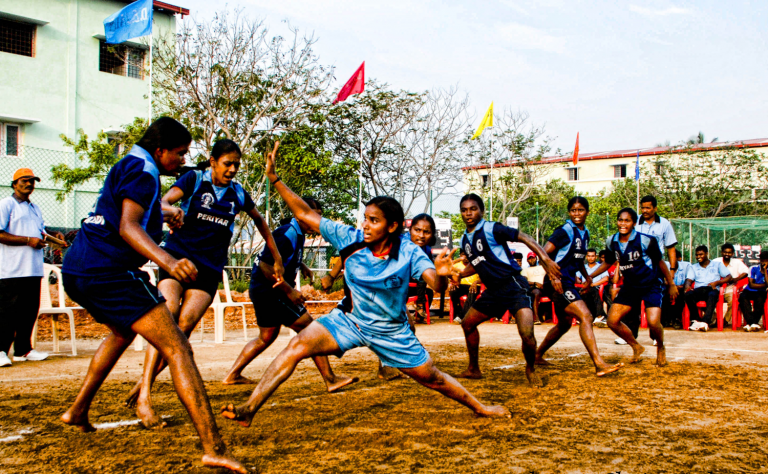
Kabadi. Photo credit: Arivazhagan89 on Wikimedia.
Cricket, baseball, rounders, and bat-and-ball sports
Teasing out the evolution of baseball is a trickey. In Northern Europe there were multiple folk versions of similar to cricket and baseball. By 1477, cricket was popular enough in England to be banned by King Edward the IV, as it distracted from military practice. So cricket was well established before baseball (or something like it) is mentioned in the historical record. But there were several baseball-type games that headed west to the New World. Baseball, in a form that we might recognize today, was established in America at by at the latest the Civil War, and likely much (much) earlier.
Rugby, American football, Aussie rules, Gaelic football, and other thrown inflated ball sports
A.K.A. “the sports where you try to murder the person with the ball.” These sports have a clearer, more linear progression than baseball. Rugby as legend has it, is an adulterated form of soccer, when a lad from Rugby, England, picked up the soccer ball and ran with it. Or, more likely, it developed out of a folk sport where rival towns tried to move an inflated pig’s bladder from one town to the next. Either way, rugby then traveled across the pond. The geographical separation slowly caused the sports of rugby and American football to drift apart.
How fast did they diverge? In 1924 the USA won the Olympic gold medal in rugby, because the rules and skills required for both sports were still so similar. 90+ years later, the two sports seem distant cousins, and the USA was not able to defend its medal when rugby returned to the Olympics in 2016. Rugby is currently one of the fastest growing sports in America (along with lacrosse). The sellout crowd at Soldier Stadium for the Ireland vs All Blacks this year hints at the growing attendence potential of test rugby in the US. Interestingly, football has recently been returning to its rugby roots. In addition to the recent popularity of more complicated running attacks (like the wildcat offense or the read-option offense), the increased scrutiny on tackling and concussion, has resulted to some football teams looking to rugby style tackling to improve safety and reduce head collision in the tackle.
Soccer and kicking sports
Soccer is a modern codification of a a very commonly played category of ancient games. Origins of the game can be traced back over two milenia to ancient Greece and Rome, as well as China. In many cases, each village, school, town, or neighborhood had its own set of local rules, games were casual, and records are scarce. It was the development and adoption of the Sheffield Rules after 1857 and the foundation of the English Football Association (1863) that lead to the spread, formalization, professionalization (and marketing) of association football (soccer comes from “assoc.”-er) and its rapid export to Europe, the Americas, and later Asia and Africa.
What’s next?
The world of continues to grow. More than 240 million people attended a professional sporting event in the 2014-2015 season, and this only accounts for the top 17 professional leagues. The Olympic Games, Tour de France, World Cup Soccer, Rugby, Test Cricket, and more these events draw millions of fans to all 7 continents (yes, there are even sports in Antarctica). The business of is expanding.
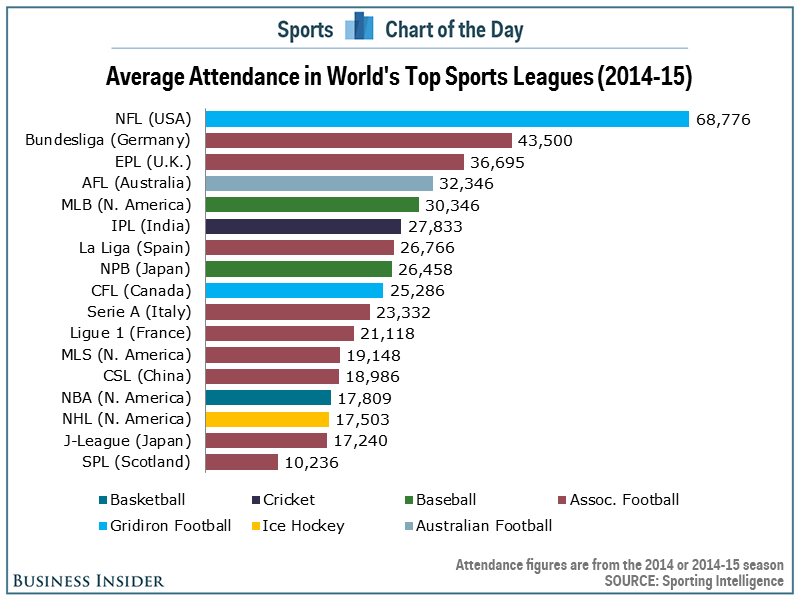
Average attendence in the world’s most popular leagues. Image credit: Business Insider
Youth and women’s participation in sports is growing exponentially. The American dominance in women’s sport, helped by the passage of Title IX in 1972. The USA won the 1991 Rugby World Cup and the team was inducted into the Hall of Fame this summer. Because the US has enjoyed greater participation by women in youth sports than other countries, the US women’s teams dominate in some sports where the men’s teams lag (soccer and rugby are excellent examples). This athletic advantage is waning now with the increase in popularity and participation by women in internationally professional sports leagues are forming for women in the US, but internationally there is greater success, equity, pay for women. In fact some WNBA players are forgoing the WNBA season so as to not jeopardize their more lucrative European contracts. This years Women’s Rugby World Cup, to be held in Ireland, sold out so quickly, and with such high demand, that venue capacity was increased.
So, what’s next for this series? Lots. We’ll take a look at what we can learn from comparing viewership numbers to attendence numbers, and what that means for the future popularity (and economic health) of different sports. After that, we’lll focus on the following topics:
- What is the state of sports today as a business and where is it heading?
- The growth in emerging sports as well as youth and women’s participation.
- How has media coverage affected the perception and popularity of different sports?
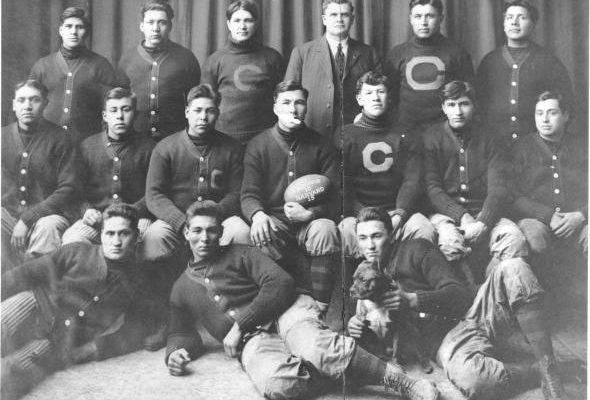

No Comments on "What can the evolution of sports tell us about its future?"